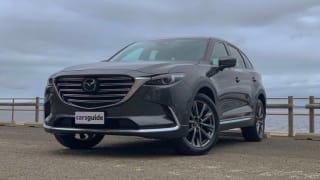
Mazda CX-9 2020 review: Azami
The Mazda CX-9 was mighty impressive when it first launched in 2016. So impressive that the MY20 is the lightest of light touches, with just a tweak here and there while leaving the good stuff well alone.
Browse over 9,000 car reviews
Close to five metres long, seven seats inside, four-wheel drive, and tipping the scales at a fraction under 2.5 tonnes, the Ford Everest Titanium isn't mucking around.
It's the circa-$70K top-spec version of the blue oval's full-size SUV, sharing much of its DNA with the Ranger dual cab ute, and competing with other big bruisers like the Toyota LandCruiser 200-Series and LandCruiser Prado, as well as Mazda's CX-9.
We spent a week climbing from base camp to the summit, to help you determine whether this Everest is the right super-size family SUV for you.
| Ford Everest 2020: Titanium (4WD 7 Seat) | |
|---|---|
| Safety rating | |
| Engine Type | 2.0L turbo |
| Fuel Type | Diesel |
| Fuel Efficiency | 7.1L/100km |
| Seating | 7 seats |
| Price from | No recent listings |
At $72,590, before on-road costs, the Everest Titanium is no small chunk of change, but Ford says that number could be higher.
Because the twin-turbo powered seven seater boasts 7.0L/100km fuel consumption (for the combined cycle) it officially qualifies as a fuel-efficient vehicle, sliding under the current Luxury Car Tax threshold ($75,526).
Still, for that kind of money you can rightfully expect a solid standard features list, and the short story is the Everest Titanium is well stocked.
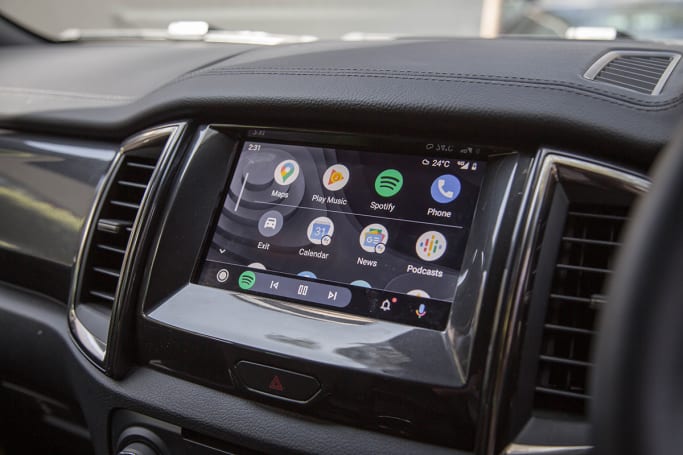
Included on the spec sheet are an 8.0-inch media touchscreen running Ford's 'Sync 3' system, incorporating 10-speaker audio, including Apple CarPlay/Android Auto integration and digital radio, as well as sat nav (with voice control and a traffic message channel).
There's also eight-way power-adjustable and heated front seats, leather-accented seat trim (excluding the third row), active noise cancellation, dual 4.2-inch digital instrument screens, dual-zone climate control, ambient lighting, 20-inch alloys, auto high-beam, LED headlights, DRLs, and (front) fog lights, a hands free tailgate, heated and folding exterior mirrors, privacy glass, a tow bar, and keyless entry and start.
Add a panoramic glass sunroof, leather-trimmed handbrake, gearshift and steering wheel, as well as auto rain-sensing wipers, the 'Terrain Management' multi-mode 4WD system, and all the safety tech detailed in the Safety section below, and you have an impressive batch of equipment.

With a yuge chrome grille dominating its nose you'd be forgiven for thinking the Everest Titanium was aimed squarely at the US market. But you'd be wrong, bigly.
As mentioned up front, the Everest is based on the Ranger dual cab ute, and both were actually designed and developed by an Asia-Pacific Ford design team based in Australia.
While the Aussie developed Ranger is now on sale in the States, the Everest isn't, and Australian examples of these models are manufactured in Thailand.
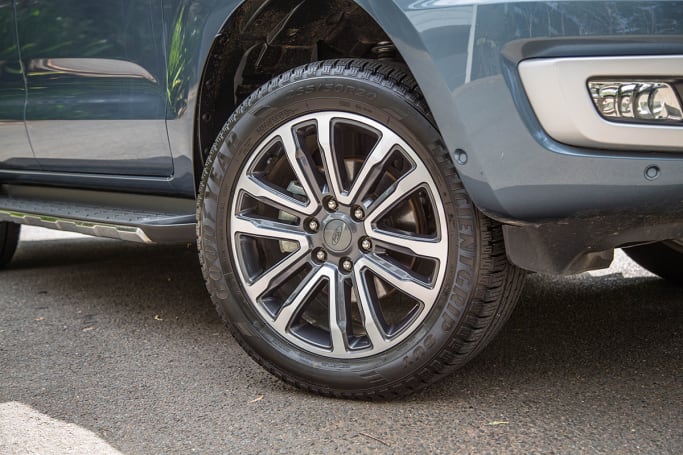
At just under 5.0m long, nearly 1.9m wide, and especially, well over 1.8m high, the Everest is an imposing vehicle,
It has the textbook high-riding SUV stance with hugely pumped up guards sitting way above big 20-inch alloy wheels.
An ultra-high waistline makes the glass area look small (it isn't, the car's just tall), broad running boards under the side doors toughen up the look, while more chrome on the mirrors, fender vents, and door handles dial up the bling.
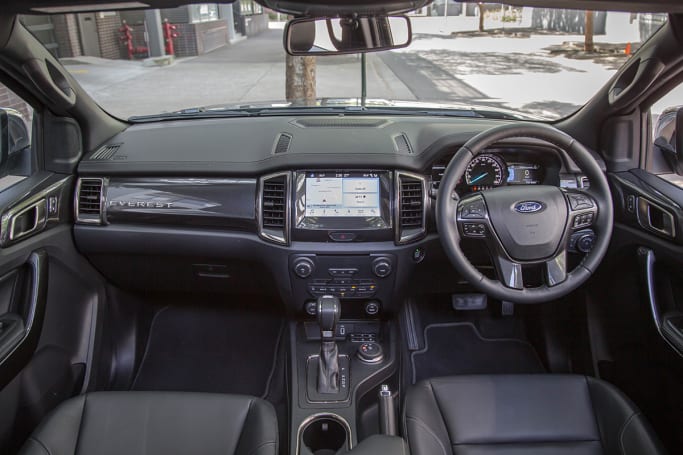
As with the bottom of the front bumper, the lower part of the Everest's rear is picked out with a matt silver finish, matching the standard roof rails. Our test car was finished in 'Deep Crystal Blue' a $650 'Prestige Paint' option.
Inside, it's conservative, inoffensive, and unlikely to raise your pulse much above resting rate, with uniformly grey materials highlighted with only an occasional flash of shiny metallic trim elements, or gloss (grey) finish on the door inserts, passenger side dash panel, and steering wheel.
The front seats look and feel comfortable, and the Everest is nicely put together but function obviously takes precedence over form.
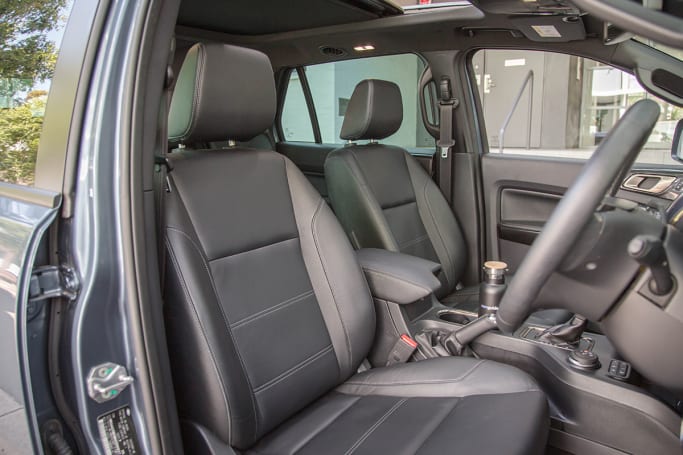
Nothing like a 2.85m wheelbase with seven-seats and a huge boot to dial up the practicality factor. The flagship Titanium adds an extra layer of features, but no matter the grade, the Everest's basic dimensions deliver great usability.
The car has clearly been designed with families in mind, and Ford has even done the arithmetic, claiming there are 30 stowage areas inside the cabin, totalling 48 litres in capacity.
Those up front are provided with plenty of space, with storage including a generous glove box, large door pockets with room for big bottles, a lidded box/armrest between the seats, two cupholders in the centre console, and a small oddments tray underneath the main ventilation controls.
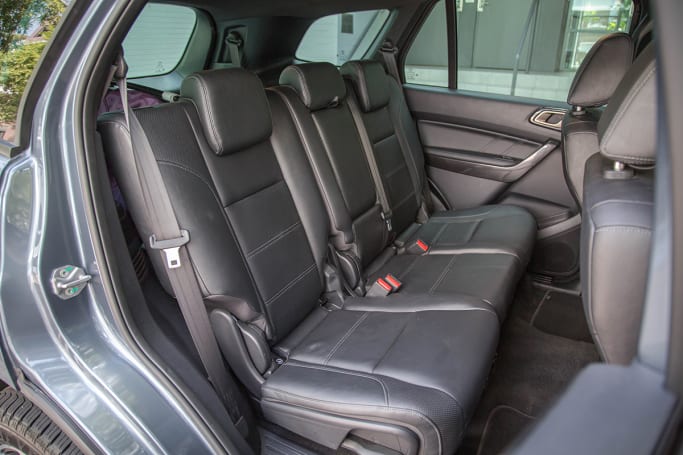
There are also multiple USB-A jacks, an overhead console with map lights and a sunglass holder, but amazingly, the steering wheel only adjusts for height, with depth/reach missing the cut. Black mark applied.
Although the seat cushion and backrest surfaces are relatively flat, rear-seaters are provided with copious amounts of head, leg, and shoulder room. Top Tip: The upside of low-relief surfaces on a folding car seat is usually a flat floor when it's lowered.
With the driver's seat set for my 183cm height I enjoyed limo-like servings of each. Even the notorious second-row centre position is large enough for a compliant adult.
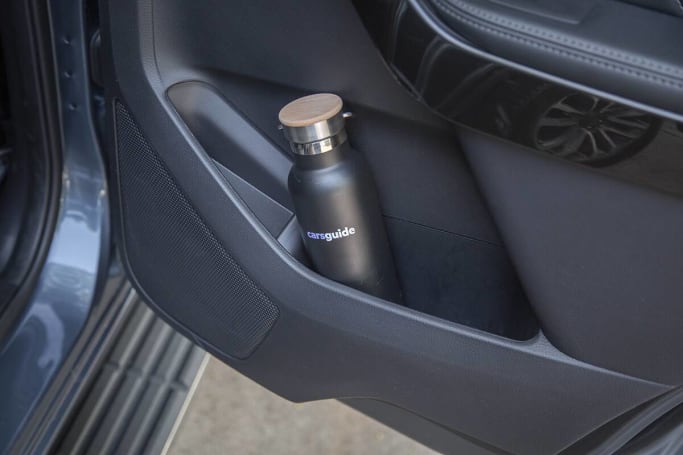
Storage runs to decent door pockets, a fold-down centre armrest with twin cupholders, and map pockets on the front seat backs. Plus, there's a 12V socket, a three-pin 230V (150W) power outlet, and individual heating and ventilation controls are always a welcome addition.
Access to the third-row seat will test your mountaineering prowess, because the (outer) centre row seat cushions don't fold. And once you've maneuvered your way into what the Cleary family likes to call the 'way back' row, it's tight.
The centre row seat slides, which is a handy piece of leverage in any turf war peace negotiation (between those in the second and third rows). There are air vents in the roof as well as a cupholder on both sides back there, but, suffice it to say for anything other than short hops those last two spots are best for pre-teen kids.
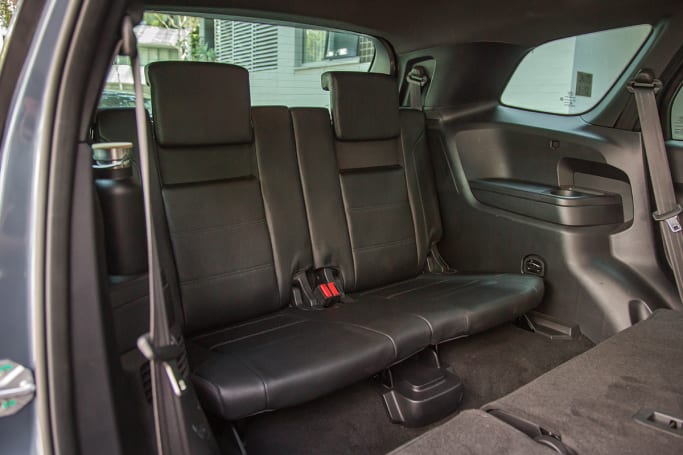
No surprise, the boot is gigantic. Even with all seats upright there's 450 litres (to the roof) available. Easily enough to swallow the largest 124-litre suitcase from the CarsGuide three-piece set, with room to spare.
Drop the power-folding 50/50 split-folding third row and that expands to 1050 litres; enough to add the jumbo CarsGuide pram. Lower the third and 60/40 split-folding second rows for a gargantuan 2010-litre capacity, with a uniformly flat floor.
There are tie-down anchor points at each corner of the main floor, as well as a 12-volt outlet and usefully bright lighting. And the power tailgate has a hands-free function. Nice.
Towing capacity is 3100kg for a braked trailer (750kg unbraked) with a Gross Combined Mass (including braked trailer) of 5900kg.
The spare is a full size 20-inch alloy, and after an untimely puncture I can confirm it's heavy, so make sure to have the powerlifting belt handy when you're swapping out a flat.
The Everest's 'EcoBlue' 2.0-litre, four-cylinder, twin-turbo diesel engine is the same unit used in the Ranger Raptor ute.
Combining an iron block with an alloy head, it features high-pressure, direct-injection, and is claimed to produce 157kW at 3750rpm and 500Nm at 1750-2000rpm.
Drive goes to all four wheels via a 10-speed automatic transmission and a permanent, variable four-wheel drive (4WD) system which includes an (electronic) locking rear diff, and has the ability to send all torque to a single wheel if required.
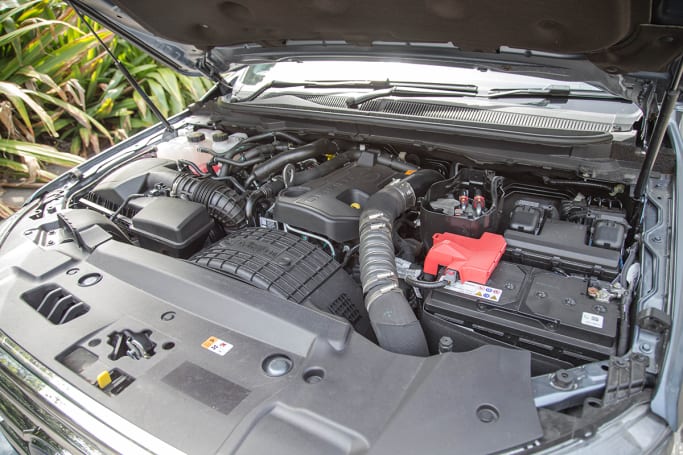
Claimed fuel economy for the combined (ADR 81/02 - urban, extra-urban) cycle is 7.0L/100km, the big Everest emitting 184g/km of CO2 in the process.
The 2.0-litre twin-turbo diesel model uses an AdBlue additive to break down and minimise nitrogen oxide (NOx) emissions (the urea-based solution is injected into the exhaust system).
Despite standard auto stop/start, over close to 250km of city, suburban and freeway running, we could only manage 8.0L/100km. Still an impressive result for such a hefty machine, and thanks to an 80-litre tank that number translates to a range of 1000km.
Although we didn't venture off-road this time around, in our recent 4x4 SUV comparison test the Everest Titanium returned 12.1L/100km in off-highway driving.
The Everest scored a maximum five ANCAP stars when it was assessed in 2015, And much as the safety body's criteria have become more stringent over the last five years Ford hasn't stood still with the large SUV's standard specification.
Already featuring active tech including 'Dynamic Stability Control' (incorporating ABS, 'Load Adaptive Control', 'Roll Over Mitigation', 'Traction Control' and 'Trailer Sway Control'), as well as 'Active Park Assist' (semi-auto parallel parking assistance), blind spot monitoring (with cross-traffic alert), and tyre pressure monitoring, in July 2019 Autonomous Emergency Braking (with pedestrian detection) was made standard across the Everest line-up.
Add a 'Lane Keeping Aid' (with 'Driver Alert System'), traffic sign recognition, auto high-beam, a rear view camera, front and rear parking sensors, adaptive cruise control, (with 'Forward Collision Alert'), as well as 'Hill Descent Control' and 'Hill Launch Assist' and you're looking at a comprehensive package.
But if an impact is unavoidable, passive safety tech includes seven airbags (driver and front passenger front, driver and front passenger side, side curtains covering all three rows, and driver's knee) as well as an 'Emergency Assistance' call-out function.
There are top tethers to locate baby capsules/child restraints for each of the five rear seats, and ISOFIX anchors on the two outer centre row positions.
Basic Warranty
5 years / unlimited km warranty
ANCAP Safety Rating

Ford Australia offers a five-year/unlimited km warranty which also covers body corrosion, and adds roadside assistance for seven years if a standard service is completed by a participating Ford Dealer annually.
Service is scheduled at 12 month/15,000km intervals, and a four year service program caps the cost at $299 for each of those dealer workshop visits. But be prepared for an extra $115 for the third year, as Ford recommends brake fluid should be replaced every three years.
But the big win is a free loan car which is scheduled with the timing of your service.
Weighing in at 2446kg, the Everest Titanium is a big bus, and if you're coming out of a conventional car be prepared to feel that mass behind the wheel.
In that context it'll feel a bit wobbly and bumpy, but relative to other large, mainstream, seven-seat SUVs the Everest sits near the top of the pyramid for ride comfort.
Suspension is independent by upper and lower 'wishbone' control arms at the front, with a solid axle at the rear, located by multi-links (including a 'Watt's Linkage', a Ford favourite over the years), and coil springs all around.
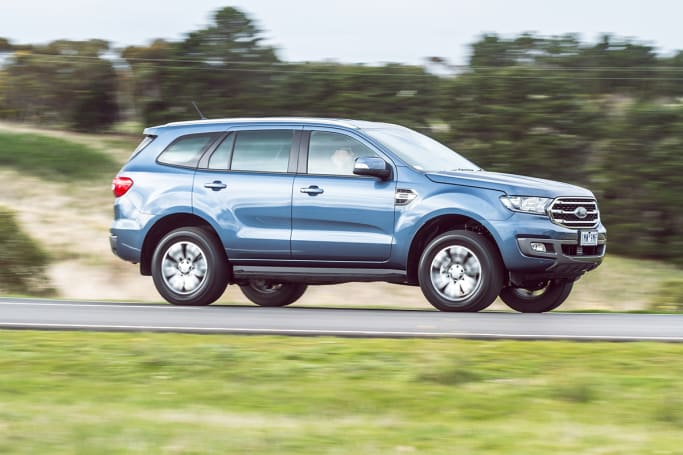
Body control is good for a car of this size, although you'll experience a fair bit of roll in cornering and a distinct shift of attitude under braking as all those kilos make their presence felt.
On paper, a 2.0-litre engine may not sound like enough to get this mountain moving. But in reality the twin-turbo, four-cylinder diesel's low-down torque is more than enough to get the job done.
Initial throttle response is doughy, but with no less than 500Nm available from just 1750rpm, and 10 ratios in the automatic transmission keeping you in the sweet spot, performance is strong.

At the same time, the top three ratios are overdriven, so freeway cruising is relaxed (and economical).
The electrically-assisted steering features what Ford calls 'pull-drift compensation technology' which means the system adapts to changing road conditions and self-corrects for things like uneven road surfaces or crosswinds.
And it works well because the Everest points accurately and assistance is pleasantly progressive.
A few grumbles. The stop-start system is a little rough, an 11.7m turning circle can make parking and tight turns a challenge, and engine noise intrudes under load.

The latter is despite installation of "three highly sensitive microphones to detect and measure engine noise then cancel it using opposing sound waves." Sounds like Ford's acoustic boffins need to do more work on this one.
As mentioned earlier, we didn't take the Everest off-road this time around, but for those that intend to, the 'Terrain Management System' uses the 4WD set-up and electronic locking rear differential to adjust for various conditions - snow, mud, grass, sand, rock and road.
And for the hardcore adventurers, the Everest's approach angle is 29.5 degrees, departure is 25.0 degrees, breakover is 21.5 degrees, ground clearance is 227mm, and wading depth is 800mm.
Practical, well-equipped, and offering solid value-for-money, as well as top-notch safety and an excellent ownership program, the Ford Everest Titanium is a great option for (large) families who like to get amongst it.
| Vehicle | Specs | Price* | |
|---|---|---|---|
| Ambiente (4WD 7 Seat) | 3.2L, Diesel, 6 SP AUTO | No recent listings | 2020 Ford Everest 2020 Ambiente (4WD 7 Seat) Pricing and Specs |
| Ambiente (rwd 5 Seat) | 3.2L, Diesel, 6 SP AUTO | No recent listings | 2020 Ford Everest 2020 Ambiente (rwd 5 Seat) Pricing and Specs |
| Ambiente (rwd 7 Seat) | 3.2L, Diesel, 6 SP AUTO | No recent listings | 2020 Ford Everest 2020 Ambiente (rwd 7 Seat) Pricing and Specs |
| Ambiente (4WD 5 Seat) | 3.2L, Hyb/Diesel, 6 SP AUTO | No recent listings | 2020 Ford Everest 2020 Ambiente (4WD 5 Seat) Pricing and Specs |
| Price and features | 8 |
|---|---|
| Design | 7 |
| Practicality | 8 |
| Under the bonnet | 8 |
| Efficiency | 8 |
| Safety | 9 |
| Ownership | 9 |
| Driving | 7 |
$38,880
Lowest price, based on 218 car listings in the last 6 months